by Rachel Pienta | Dec 9, 2022
What is a Youth-Adult Partnership?
“Youth-adult partnership” is a frequently used phrase among 4-H leaders, volunteers, and members. Volunteer club leaders are encouraged to foster youth-adult partnerships in the community club environment. What is a youth-adult partnership? How would a volunteer club leader begin to create this type of partnership? What is the adult role in the youth-adult partnership? Research shows that “caring, knowledgeable, and skilled adults can contribute to the success of young people as they grow and develop (Norman and Jordan, 2006). The first step in creating a youth-adult partnership is being the adult who wants to foster that environment in their 4-H club.
Positive Youth Development
4-H programs are built on a Positive Youth Development foundation. To further unpack what that phrase means, let’s begin with defining youth development. Norman and Jordan (2006) define “Youth development as an ongoing process through which young people attempt to meet their needs and to develop the competencies they perceive as necessary for survival and transition to adulthood.” When youth development is positive, this development has positive benefits and outcomes for the youth and the community. While youth development is a youth-focused process experienced by the youth, adults can and do play a role in this process. Adult leaders have the unique and special role of creating environments that provide opportunities to develop and grow in positive ways.
Zone of Proximal Development and the Role of the Adult Leader
Sociologist Lev Vygotsky studied how children learn and acquire skills. Through his research, he was able to determine that children can develop and learn to a certain point based on prior experience and knowledge. With the help of an adult teacher or leader, the child can learn more and acquire skills beyond what he or she might be able to accomplish without adult help. This learning theory is known as the “Zone of Proximal Development” (Vygostky, 1978). In 4-H, reaching the zone of proximal development where the youth-adult partnership empowers youth members to achieve is the goal we work to reach.
Working with Youth as Partners
The origin of today’s 4-H youth-adult partnership model is rooted in the work of sociologist William Lofquist. Lofquist (1989) developed the “Spectrum of Attitudes” to describe adult attitudes and approaches to working with youth. The Spectrum of Adult Attitudes places attitudes towards young people into three categories: Youth as objects; Youth as recipients; and Youth as partners (Williams, 2016). Lofquist noted that adult attitudes and the behaviors that result from these attitudes were not necessarily linear or clear cut. Youth needs may drive adult behaviors at different points in the learning and partnership process. In 4-H, adult leaders strive to transition youth from being knowledge recipients to being partners in learning and doing.
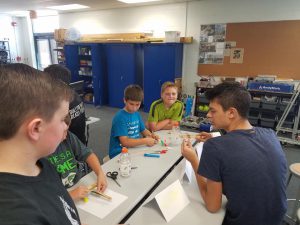
High school-age 4-H youth members plan and lead a 4-H robotics club.
Getting Started
Adults can foster and support successful youth-adult partnerships by creating and “providing environments for youth that are safe and nurturing and by expanding opportunities for experiences that will help young people develop skills they need for adulthood” (Norman and Jordan, 2006).
The idea of moving from an adult-led club to a club that operates as a youth-adult partnership may seem intimidating. Where do we start? How does it work? Volunteer club leaders may find that it takes a while to develop a community club that functions as a successful youth-adult partnership. Adults and youth may learn together as adults yield control and youth step into expanded leadership roles.
Tips for Establishing a Youth-Adult Partnership
In the club setting, creating space for shared decision-making can help build the youth-adult partnership. When adults make decisions “with” rather than “for” youth, space is created for youth voices to be heard, for youth decisions to be validated, and for youth to develop as leaders.
When youth make decisions about activities and projects, they begin to have ownership over the club experience and move toward acting as fully empowered partners with adult leaders.
How can adults create an environment that gives youth space to develop and grow as partners? Adult leaders can start building the youth-adult partnership by helping youth develop key skills to lead and run club meetings. Steps to reaching an effective youth-adult partnership include the following activities:
- Electing youth officers and providing officer training.
- Providing whole club training in parliamentary procedure with meeting procedure practice.
- Agenda planning that includes youth and adults.
- Adults joining youth-led meetings as participants.
- Setting ground rules so that everyone is heard and respected
Getting Started
For more information and resources on 4-H clubs and youth-adult partnerships, reach out to your local Extension office or 4-H agent.
We also have several tools and resources for office training, parliamentary procedure games, and agenda planning on our Northwest 4-H Volunteer Google Site. If you would like some hands-on training, make plans to attend our Northwest 4-H Volunteer Forum January 20-21 in Destin, Florida. Registration is available on 4HOnline
References
Lofquist, W. 1989. The technology of prevention workbook: A leadership development program. Tucson, AZ: Associates for Youth Development Publications.
Norman, M.N. and Jordan, J.C. 2006. Introducing 4-H youth development. EDIS 4HFFS101.2, one of a series of the 4-H Youth Development Department, UF/IFAS Extension. Original publication date February 2006. Reviewed July 2018. Visit the EDIS website at http://edis.ifas.ufl.edu.
Vygotsky, L. 1978. Interaction Between Learning and Development. In Gauvain & Cole (Eds.) Readings on the Development of Children. New York: Scientific American Books. pp. 34-40
Williams, C.D. 2016. What is authentic youth engagement? The Governor’s Office for Children. Maryland.gov. https://goc.maryland.gov/authentic-youth-engagement/.
Additional Resources
A 4-H Club Meeting
4-H Club Management
4-H Clubs that Youth Choose to Attend
Running a Smooth 4-H Business Meeting
by Rachel Pienta | Sep 12, 2022
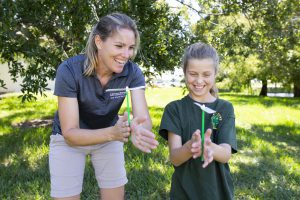
.
What is Subject Matter Expertise?
Subject matter expertise refers to the “technical knowledge and skills possessed to perform tasks related to a specific field(s)” (Harder, 2019). While county 4-H professionals (also known as agents) often bring subject matter expertise in one or more areas to the job, the subject matter expertise of program volunteers helps to expand the availability of potential program offerings. As an organization, 4-H strives to provide opportunities for learning evidence-based content (subject matter) and apply age-appropriate positive youth development (PYD) strategies to facilitate experiential learning via a collaborative youth-adult partnership.
What is a Subject Matter Expert?
Subject Matter Experts (SMEs) “are professionals who have advanced knowledge in a specific field” (Indeed, 2020). Generally, an SME will have “a deep understanding of a particular job, process, department, function, technology, machine, material or type of equipment” (Reh, 2020). In the workplace, being known as an SME is part of a career trajectory and this role or status is often based on a combination of education or training and experience. In the 4-H setting, it is possible that a subject matter expert has gained expertise through informal learning and hands-on experience. The 4-H subject matter expert may not always work professionally in the area of expertise that they bring to 4-H. For example, a skilled volunteer may work as a nurse in their professional career but leads a 4-H sewing club where she can share a deep knowledge subject knowledge and extensive skills gained through years of practice and self-guided study.
Why is Subject Matter Expertise Important to 4-H?
In 4-H, adult staff members and community volunteers work as partners with youth members to help youth “learn by doing.” The 4-H learning experience is based on the idea that “learning is an integrated process where the learner, the educator, the physical space, and culture all are changed by each other” (NIFA, 2016). 4-H clubs provide youth with opportunities to learn subject matter and develop life skills (Knowles and Diem, 2018).
While adults and youth may learn a new skill or acquire new knowledge together in a discovery process, the most common 4-H experience involves working with a subject matter expert who will help to facilitate experiential learning. 4-H learning is intended to be a “dynamic experience in a shifting learning ecosystem” (NIFA, 2016). Together, 4-H staff and community volunteers work together to bring new research and best practices into the learning experience.
How Do We Find Subject Matter Experts?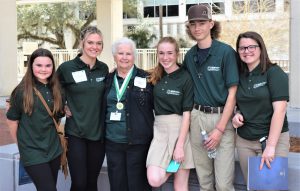
One way that 4-H can provide specialized subject matter content is through partnerships. For example, 4-H has been successful in partnering with industry professionals and university faculty to implement a variety of STEM programs. A multiyear partnership with NASA has provided many opportunities for youth to explore the world of aerospace science. However, it is not necessary to be a rocket scientist to have subject matter expertise that can be helpful to a 4-H program.
In 4-H, agents have several options available to help develop volunteer subject matter expertise. Agents may look for potential volunteers with specific subject matter expertise to match youth interests. Another option is to engage a caring adult volunteer with a desire to learn an unfamiliar skill or acquire a new knowledge set. For example, a 4-H agent with youth members who want to have a beekeeping club may find a local beekeeper to be a club leader. Another way to match a volunteer with a potential beekeeping club would be to find the adult and arrange for them to attend an Extension education program on beekeeping. Finally, it is also possible to have a volunteer with positive youth development skills that can lead a club and invite guest speakers with expertise to provide subject matter content.
Over time, youth may also become subject matter experts. For example, youth members in Wakulla participated in a poultry science club as Cloverbud and Junior members. After several years of completing projects and participating in competitions, these youth have gained considerable subject matter expertise and have started to teach content and skills to other youth at annual workshops.
Volunteers who want to increase their subject matter knowledge and expertise will find a wealth of resources within 4-H and the larger world of Cooperative Extension. Varied modes of learning are possible – from online seminars, to resource-rich publications, to hands-on experiential learning. For example, volunteers had the opportunity to network with subject matter experts and have robust experiential learning opportunities during our Northwest 4-H Volunteer Forum. After the Forum weekend, volunteers shared that the the event provided opportunities for them to network and connect with other volunteers to gain access to subject matter and experiential expertise. By popular demand, the Northwest 4-H Volunteer Forum will return in January 2023. Watch this space for additional details on how to connect and be part of the weekend event!
How to Get Involved
Do you have a passion for a particular subject matter area, or do you have a skill that you want to share? A variety of volunteer roles with 4-H are possible. Volunteers may serve as club leaders or project leaders, or be a guest instructor, or be a judge for a competition. We would like to build a directory of subject matter experts to support 4-H volunteers and clubs across the Florida Panhandle. If you have expertise you would like to share, please complete this short survey.
Remember, you do not necessarily have to be a subject matter expert to get started as a 4-H volunteer! If you are a caring adult with a desire to learn new skills and play an important role in the lives of youth in your local community, 4-H can help you gain new skills to help guide youth in a transformative learning experience. We offer subject matter trainings for volunteers throughout the year on a variety of topics.
For more information about how to become a 4-H volunteer, contact your local UF/IFAS Extension office.
Resources
4-H Learning Experience
Priorities Competencies for County Faculty
Subject Matter Expert
The 4-H Volunteer Training Series
What is Subject Matter Expert?
by Heather Kent | Aug 29, 2022
 We are excited to announce registration for our 2023 Northwest Florida 4-H Volunteer Forum will open on October 15th! This post contains all the details about our event- who, what, when, where, and how. We hope you will plan to join us for an inspirational Friday night and Saturday as we connect with each other, learn together, and share our successes. Our theme is “Navigating the World of 4-H.” Together, we will learn about empowering youth, inspiring hope, and helping young people reach their full potential.
We are excited to announce registration for our 2023 Northwest Florida 4-H Volunteer Forum will open on October 15th! This post contains all the details about our event- who, what, when, where, and how. We hope you will plan to join us for an inspirational Friday night and Saturday as we connect with each other, learn together, and share our successes. Our theme is “Navigating the World of 4-H.” Together, we will learn about empowering youth, inspiring hope, and helping young people reach their full potential.
WHO
|
Our volunteer forum is for teen and adult volunteers leading and supporting 4-H clubs, groups, or programs in the northwest Extension district. |
WHAT
|
A weekend (Friday night and Saturday) event full of inspirational speakers, hands-on workshops, and opportunities to connect with and support other volunteers! Topics were identified based on last year’s forum participants’ feedback. Feel free to download the agenda and informational flyer. This post highlights some of the activities you won’t want to miss:
Friday night kicks off with our “Make and Take” Fair. Try out a wide variety of fun and exciting 4-H activities you can use with the clubs or groups you work with. Each time you visit a station, you can get your “passport” stamped! There will be selections to support all three 4-H pillar project areas- Healthy Living, STEM (science), and Citizenship/Leadership. During the Make and Take Fair, heavy hors d’oeuvres will be served and you will have the opportunity to test out the activities and take home samples and instructions to share with your youth, parents, and other volunteers.
After the make-and-take fair, we will have a fun icebreaker, and Dr. Stacey Ellison, our 4-H Program Leader, will speak and give a “state of 4-H” update and share strategies for inclusion and diversity. Volunteers are encouraged to network and mingle after her address.
Saturday morning will inspire! Gulf County 4-H Alumnus and best-selling author, Cedric Lennox, will share how his Florida 4-H experiences taught him about youth empowerment and how we can all be “Dealers of Hope.”
Following the keynote address, volunteers will be able to select from a variety of workshops:
- Road Map to Parliamentary Procedure
- Charting a Successful Sports Fishing Project
- Culinary Adventures with the 4-H Food Challenge
- Trek through Teambuilding
- Tour of 4-H Gardening Project
- Smooth Sailing with Cloverbuds
During lunch, connect with other volunteers who have similar interests as you to start building a community of practice for your 4-H clubs and groups! Dr. Jenny Jordan will share expert tips for Experiential Learning (or learn-by-doing).
After lunch, there will be more workshop selections for volunteers to choose from:
- Guide to 4-H Awards, Recognition, & Portfolios
- Voyage through the 4-H Clothing & Textiles Project
- Hike through the “Big Book of Cloverbuds”
- Survey of Service Learning
- Expeditions in Entomology
- A Mindfulness Pilgrimage
We will close our forum by sharing some exciting new resources- including a fundraising toolkit for 4-H volunteers (and more door prizes!). |
WHEN
|
January 20-21st. |
WHERE
|
Embassy Suites in Destin, Florida. No need to make a reservation- your registration is your hotel reservation confirmation! |
HOW
|
Registration opens in 4Holine on October 15th. The deadline to register is Friday, January 6th. Check with your local UF/IFAS Extension office to inquire about carpooling to and from the event. Dress for the weekend is casual (and comfortable)- we will be at the beach! |
HOW MUCH
|
Thanks to donations from the Florida 4-H Foundation and other partners, the registration fee for individuals sharing a suite with another volunteer is $100. The registration fee for a private suite is $150. The registration fee includes the room fee, a conference welcome bag, magnetic name tag, heavy hors d’oeuvres Friday night, breakfast and lunch on Saturday, plus workshop and make-and-take supplies. Many counties are offering scholarships, so please check with your local UF/IFAS 4-H Extension Agent about additional funding. |
by Niki Crawson | Aug 26, 2022
 Joining a new group of individuals can be nerve-wracking for some that may be shy or intimidated by large groups. Incorporating team-building activities into your 4-H clubs and activities is a great way for 4-H members, new and returning, to form a connection with each other and will help set the tone for that particular group setting and/or event. In this post, we’ll provide tips to bring engaging team-building activities into your 4-H clubs and events. In addition, we will share some of the most popular team-building activities for various age groups that you can use to support your work with 4-H youth.
Joining a new group of individuals can be nerve-wracking for some that may be shy or intimidated by large groups. Incorporating team-building activities into your 4-H clubs and activities is a great way for 4-H members, new and returning, to form a connection with each other and will help set the tone for that particular group setting and/or event. In this post, we’ll provide tips to bring engaging team-building activities into your 4-H clubs and events. In addition, we will share some of the most popular team-building activities for various age groups that you can use to support your work with 4-H youth.
Together Everyone Achieves More
Teambuilding has been proven to have many benefits. Two of the most powerful benefits of team building are increased group morale and individual confidence. Having a new group of individuals learn to work collectively as a team builds rapport and trust. Teambuilding allows individuals to contribute their strengths to the team and also gain additional skills learned from others within the group. This allows for personal growth and development… However, teambuilding does not happen on its own- teams are formed over time with good leadership.
Bruce Tuckman’s Forming-Storming-Norming-Performing model (1965) is arguably the most recognized model for team development, and includes four stages of team development: Forming, Storming, Norming, Performing, and Adjourning:
- Forming: The leader shares goals, but there is no commitment yet; individual roles and responsibilities are unclear. Very leader driven at this point. This stage is essential to help reduce anxiety new members might feel joining a 4-H club or group and will help foster a sense of belonging.
- Storming: Trust hasn’t been established and decisions are difficult to make. Team members try to establish credibility with the group toward the end of this stage.
- Norming: The group is establishing trust—agreement is easier to reach, commitment to goals is evident, and decisions are being made.
- Performing: The group could function on its own without the leader because of the trust, commitment to goals, clarity, and ease of making decisions.
- Adjourning: Recognition and sensitivity to the break-up of the group is important as the team dissolves and members move on to other tasks.
Five Team Building Tips for 4-H Clubs or Groups
Below are five helpful tips for incorporating hands-on activities into your 4-H clubs and events in order to have successful teambuilding interaction:
- The teambuilding process can be longer for some groups than others- it really depends on the needs of the group and how often they meet or interact. If your group meets once a month, it might take longer than if your group is in the same cabin all week at camp.
- Select activities that will address the current needs of your group- if the group is already formed, move on to activities that promote storming.
- If you see a club or activity struggling with a group activity or plan of action, have them take a break and let them participate in a fun
 teambuilding exercise like “Helium Stick“
teambuilding exercise like “Helium Stick“
- Check out our Northwest 4-H Volunteer Google Site for more team-building activities and resources.
- Team building isn’t just for the youth! Consider planning a teambuilding workshop or a night of minute-to-win-it games with your youth vs volunteers or even a 4-H Family night with youth, parents/guardians, and volunteers. This will become a request for an annual event guaranteed!
Five Team Building Activities for “Forming”
The new 4-H year kicks off in just a few days, which means that most 4-H clubs or groups are in the “forming” stage. To help, below are five fun and easy activities you can do with your team to promote “forming.” For more activities and ideas to support all five stages of team building, download our free 4-H Team Building Handbook for a quick reference tool!
- Start your meeting with an easy get-to-know-you icebreaker like “The Superlative Game” in which youth line up based on their birthday, height or age without talking.
- Who’s in the Bag? Ask each person to select an object that represents something about themselves. You can have a variety of objects available for them to select from, or they can bring an item with them. Have each person place their item in the bag, then let each person take turns explaining why the object represents something about themselves.
- Common & Unique- Ask everyone to form a circle. Tell them that you will ask a series of questions, and if the question applies to them, they are to stand inside the circle. Ask questions like “I am the oldest child in my family,” or “I play a sport,” or “I have lived in another state.” This helps members of the group get to know things about other members that they can’t see with their eyes.
- Introductions- Pretend you are hosting a party where no one knows anyone else. Have everyone standing in no particular order. In a party spirit, walk up to one of your “guests” and introduce yourself by name. For example:
- “Hi, I’m Karly. What’s your name? Gabrielle? Hi, Gabrielle, glad to meet you. Come on, there’s someone I want you to meet.” You then take Gabrielle to meet another “guest.”
- “Hi, what’s your name? Paul? Hi, Paul; this is Gabrielle. Gabrielle, this is Paul.” Gabrielle and Paul play it up. They smile, shake hands and say “Glad to meet you.”
- Try to “introduce” everyone in three minutes.
- If you need to meet virtually, don’t skip the team-building activity. Try this activity, “Where Am I?”
By incorporating teambuilding activities into your 4-H delivery, you will be delivering enhanced educational experiential learning in order for our youth to engage in mentally, physically, and socially, fostering the development of essential life skills. To learn more about joining 4-H as a member or volunteer, please contact your local UF IFAS County Extension Office, or visit http://florida4h.org.
SOURCES:
Building A Team Within A 4-H Club. Ohio State University. https://citeseerx.ist.psu.edu/viewdoc/download?doi=10.1.1.230.6481&rep=rep1&type=pdf
Team Building Activity: Helium Stick. Guide, Inc. 2021. https://guideinc.org/2017/08/21/team-building-activity-helium-stick/
The Superlative Game. North Dakota 4-H Recreation Games & Activities. Page 11. https://www.ndsu.edu/fileadmin/4h/ClubMaterials/FJ825_Games___Activities.pdf
Tuckman, B. W. (1965). Developmental sequence in small groups. Psychological Bulletin, 63(6), 384–399.
Why Icebreakers? (2:17) – 4-H Military Partnerships Website – University of Florida/Florida 4-H. https://youtu.be/zWIkGgdEekM
by Heather Kent | Aug 4, 2022
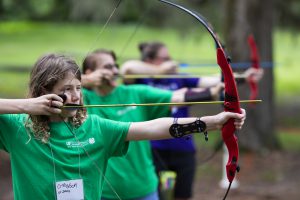
4H youth participate in archery at 4H Camp Cherry Lake. Photo taken 06-08-19.
4-H volunteers and professionals often find themselves teaching a wide variety of audiences with different needs for learning. Keeping youth of different ages and abilities engaged in project learning can be a challenge, so we are offering six specific strategies that will make this much easier- especially with practice! Last week’s post covered spacing, interleaving, and retrieval practice. This week, we will talk about elaboration, concrete examples, and dual coding. This post will also include examples of using these techniques in your work with youth.
Isn’t the 4-H Curriculum “Good Enough?”
Yes! ……And no. Some 4-H curricula have teaching strategies embedded within them. Some just have activities structured to help youth learn content. Sometimes the curriculum was not written for the age group you are working with- in that case, check out our series on applying “ages and stages” to adapt activities for youth. Learning and applying a few of these teaching strategies will make your teaching more interesting and engaging to a wider range of 4-H members. These strategies are not hard, and require a little forethought- but the return on investment can be huge. Engagement + interest = more fun for everyone!
Elaboration

Experiential learning cards are quick reference tools when using elaboration
Elaboration is simply taking the time to ask and explore how and why things work the way they do. In the 4-H world, this is part of the “reflect and apply” part of our learn-by-doing model. To be included in the 4-H Curriculum Clearinghouse (a list of approved curricula for Florida 4-H), the curricula must include opportunities for elaboration. Taking the time to dig deeper into the content this way helps youth connect the information to everyday life, and this helps the information anchor in your memory.
Before rushing to the next activity on the agenda, ask youth to reflect on what they have learned and how they might apply it to another situation. Below are some examples of questions you might ask to help youth elaborate. Another tool that is handy is the 4-H Experiential Learning Flash Cards- each card has sample questions you can use when teaching or facilitating an activity to help youth elaborate. You can order a set from the UF/IFAS Book Store or contact your local UF/IFAS Extension office.
-
- What did you learn about (life skill or activity subject matter) through this activity?
- What did you learn about yourself by doing this activity? How did others help you?
- How did you make your decisions? What steps did you take?
- What problems came up over and over? How did you handle them?
- What key points have you learned?
- Have you had similar experiences related to this project/activity?
- Where have you faced similar challenges in your life?
- How does what you learned relate to other parts of your life?
- How can you use what you learned?
- How can you apply (the life skill you practiced) in the future?
Concrete Examples
Providing specific examples can also help anchor ideas and concepts in a person’s memory. This works particularly well for younger members (juniors and intermediates) who are just starting to understand more abstract ideas. Providing more than one example helps the learner apply the information, not just remember the concept.
For example, the idea of computer coding can be an abstract concept for youth (and even some adults). One concrete example is to compare computer coding with the language we speak. You have to understand the language before you can communicate. Another example is to play “Simon Says.” In this familiar game, the players can only do exactly what “Simon” says to do otherwise they are out of the game. The same is true for computer coding. The computer will only do exactly what the programmer says to do.
Dual Coding
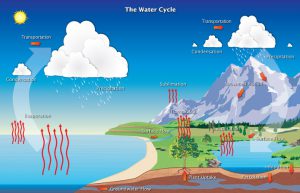
Image credit: The water cycle by NOAA National Weather Service
Dual coding is a fancy term for using words and visuals together. Research has shown that words and visuals help learners learn better than words alone or visuals alone. Some 4-H curricula do a great job including visuals- other times, you may need to search the internet or YouTube to find good visuals for more complex ideas.
For example, when teaching youth about the water cycle, a diagram of the water cycle is very helpful. Alternatively, you could show youth how to make a water cycle bracelet, where each bead represents a different part of the cycle. That way, they have a visual they can wear and refer to when exploring the water cycle.
One of the best things about 4-H is it is learner-centered. That means that youth can choose what they want to do and learn in 4-H. Your local 4-H Extension Office can help you find the best curriculum to support your youths’ learning needs, but the curriculum is only part of learning. 4-H supports learning (usually referred to as a project) through a variety of competitive and non-competitive events. The three strategies described in this post can help volunteers and 4-H professionals link learning between projects and activities. I hope this series has been helpful as you prepare to work with 4-H youth this year to “make the best better!”
References:
- Potter, S. (2021). Educational Design and Delivery – Utilization of Multiple Teaching Strategies. 4-H VKRC Fact Sheets.
- Weinstein, Y., Madan, C. R., & Sumeracki, M. A. (2018). Teaching the science of learning. Cognitive Research: Principles and Implications, 3, 2. https://cognitiveresearchjournal.springeropen.com/articles/10.1186/s41235-017-0087-y
- Weinstein, Y, Sumeracki, M & Caviglioli, O (2019) Understanding how we learn: A visual guide. Routledge, Abingdon, Oxon, UK.
by Heather Kent | Jul 28, 2022
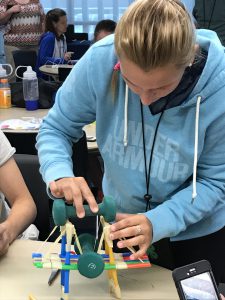 Whether you are a teen helping with a day camp, or an adult leading a club- it helps to have some tips and tricks in your back pocket to teach the content you want 4-H members to learn. 4-H volunteers and professionals often find themselves teaching a wide variety of audiences with different needs for learning. Trying to meet all those needs can sometimes seem overwhelming, but this week and next, our blog will focus on six specific strategies that will make this much easier- especially with practice! This blog post will discuss and give examples of three teaching strategies that can up your teaching and facilitation game- spacing, interleaving, and retrieval practice.
Whether you are a teen helping with a day camp, or an adult leading a club- it helps to have some tips and tricks in your back pocket to teach the content you want 4-H members to learn. 4-H volunteers and professionals often find themselves teaching a wide variety of audiences with different needs for learning. Trying to meet all those needs can sometimes seem overwhelming, but this week and next, our blog will focus on six specific strategies that will make this much easier- especially with practice! This blog post will discuss and give examples of three teaching strategies that can up your teaching and facilitation game- spacing, interleaving, and retrieval practice.
Why Bother? Isn’t the 4-H Curriculum “Good Enough?”
Some 4-H curricula have teaching strategies embedded within them. Some just have activities structured to help youth learn content. Learning and applying a few of these teaching strategies will make your teaching more interesting and engaging to a wider range of 4-H members. Engagement + interest = more fun for everyone!
Spacing
The term “spacing” simply means to spread learning out over time. When information is learned over the course of several weeks, months, or even years, youth (and adults) are more likely to retain that information than if it were dumped on them over several hours or days. This is why 4-H projects are so effective- youth often stay with the same project for one or more years, learning more complex information each year until they have mastered the content. Some project work even leads to future careers.
Here is an example of how you might apply spacing to the youth you work with in 4-H: One of the things youth want to do this year is participate in the Consumer Choices contest. Rather than teaching a marathon Saturday workshop the week before the contest, start early and introduce the concepts slowly either as part of a club meeting or an extra session before or after the regular club meeting time.
- Meeting #1- Explain why consumer skills are essential, what the topics for this year’s contest are, and the contest rules
- Meeting #2- Review cell phone plans and portable speakers (two of the topics). Demonstrate how to fill out a judging card and practice judging situations for cell phone plans and speakers.
- Meeting #3- Review ground transportation and smoothies (two more topics). Review how to fill out a judging card and practice judging situations.
- Meeting #4- Explain what oral reasons are- have an older youth demonstrate or what videos of youth giving oral reasons. Next, hold a mock contest and let youth practice giving oral reasons.
Interleaving (not to be confused with interweaving)
Interleaving means switching between topics. This allows youth opportunities to practice life skills in different situations. This helps reinforce the life skills that we teach in 4-H. For example, judging contest strategies are the same- it’s just the content that changes from contest to contest. Judging contests help youth learn about different topics, but the real value is they are learning how to think critically, communicate clearly, and work as a team. Applying those same skills to different subject matter helps youth learn lifelong skills (not just how to regurgitate facts). Here’s an example of interleaving that builds on the consumer choices example above:
The youth you work with will also want to learn about robotics, so you introduce an activity from the 4-H Junk Drawer Robotics curriculum. You divide the youth up into groups of three to complete a challenge to build a robot that draws. While teaching, refer back to what youth learned about critical thinking when they competed as a team in consumer choices. What did they learn about communication and teamwork? Ask them to apply those lessons to this situation when building a robot.
Retrieval Practice
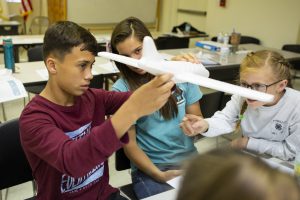
4H youth work together in a drone course. Photo taken 10-15-18.
One of the best ways to strengthen your memory is to practice retrieving that information from your brain! Many of our 4-H curricula include games that allow youth to practice information retrieval. Quiz bowls and skill-a-thon stations are two great ways to incorporate retrieval practice. Here is an example of retrieval practice that builds upon the consumer choices example:
Youth enjoyed participating in the consumer choices contest and asked if they could do more activities like that. Your local 4-H agent suggested a program called “Living on My Own” which is a financial simulation that helps teach financial literacy skills. As the youth rotate through the stations, they retrieved and practiced some of the consumer skills they learned earlier as they decided on housing, transportation, food, and other items based on their simulated salary and living situation. Being about to recall and practice these skills helps reinforce financial literacy.
One of the best things about 4-H is it is learner-centered. That means that youth can choose what they want to do and learn in 4-H. Your local 4-H Extension Office can help you find the best curriculum to support your youths’ learning needs, but the curriculum is only part of learning. 4-H supports learning (usually referred to as a project) through a variety of competitive and non-competitive events. The three strategies described in this post can help volunteers and 4-H professionals link learning between projects and activities. Next week’s post will explore three more strategies for teaching youth- elaboration, concrete examples, and duel coding.
References:
- Potter, S. (2021). Educational Design and Delivery – Utilization of Multiple Teaching Strategies. 4-H VKRC Fact Sheets.
- Weinstein, Y., Madan, C. R., & Sumeracki, M. A. (2018). Teaching the science of learning. Cognitive Research: Principles and Implications, 3, 2. https://cognitiveresearchjournal.springeropen.com/articles/10.1186/s41235-017-0087-y
- Weinstein, Y, Sumeracki, M & Caviglioli, O (2019) Understanding how we learn: A visual guide. Routledge, Abingdon, Oxon, UK.











